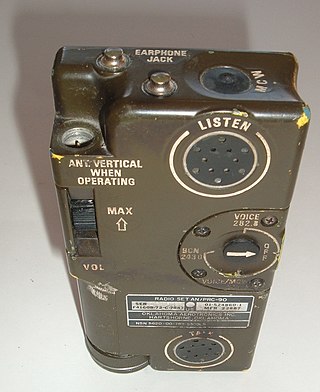
Intelsat S.A. is a multinational satellite services provider with corporate headquarters in Luxembourg and administrative headquarters in Tysons Corner, Virginia, United States. Originally formed as International Telecommunications Satellite Organization, from 1964 to 2001, it was an intergovernmental consortium owning and managing a constellation of communications satellites providing international telecommunications and broadcast services.

The International Mobile Satellite Organization (IMSO) is the intergovernmental organization that oversees certain public satellite safety and security communication services provided via the Inmarsat satellites. Some of these services concern:

An emergency position-indicating radiobeacon (EPIRB) is a type of emergency locator beacon for commercial and recreational boats, a portable, battery-powered radio transmitter used in emergencies to locate boaters in distress and in need of immediate rescue. In the event of an emergency, such as a ship sinking or medical emergency onboard, the transmitter is activated and begins transmitting a continuous 406 MHz distress radio signal, which is used by search-and-rescue teams to quickly locate the emergency and render aid. The signal is detected by satellites operated by an international consortium of rescue services, COSPAS-SARSAT, which can detect emergency beacons anywhere on Earth transmitting on the distress frequency of 406 MHz. The satellites calculate the position or utilize the GPS coordinates of the beacon and quickly passes the information to the appropriate local first responder organization, which performs the search and rescue. As Search and Rescue approach the search areas, they use Direction Finding (DF) equipment to locate the beacon using the 121.5 MHz homing signal, or in newer EPIRBs, the AIS location signal. The basic purpose of this system is to help rescuers find survivors within the so-called "golden day" during which the majority of survivors can usually be saved. The feature distinguishing a modern EPIRB, often called GPIRB, from other types of emergency beacon is that it contains a GPS receiver and broadcasts its position, usually accurate within 100 m (330 ft), to facilitate location. Previous emergency beacons without a GPS can only be localized to within 2 km (1.2 mi) by the COSPAS satellites and relied heavily upon the 121.5 MHz homing signal to pin-point the beacons location as they arrived on scene.

David A. Gross is an American lawyer and former U.S. Coordinator for International Communications and Information Policy at the U.S. State Department's Bureau of Economic and Business Affairs.
The Global Maritime Distress and Safety System (GMDSS) is a worldwide system for automated emergency signal communication for ships at sea developed by the United Nations' International Maritime Organization (IMO) as part of the SOLAS Convention.

The European Telecommunications Satellite Organization is an intergovernmental organisation consisting of 49 member states. It is headquartered in Paris, France. The mission of EUTELSAT IGO is to maintain the rights to use radio frequencies and orbital locations which were assigned collectively to the Member States by the International Telecommunication Union (ITU) and to oversee the operations of Eutelsat S.A. so as to ensure that the company complies with the international EUTELSAT Convention. EUTELSAT IGO plays an active role within the global telecommunications community and is a key actor in the satellite business sector.

The International Telecommunications Satellite Organization (ITSO) is an intergovernmental organization charged with overseeing the public service obligations of Intelsat, which was privatized in 2001.
COMSAT is a global telecommunications company based in the United States.

The International Cospas-Sarsat Programme is a satellite-aided search and rescue (SAR) initiative. It is organized as a treaty-based, nonprofit, intergovernmental, humanitarian cooperative of 45 nations and agencies. It is dedicated to detecting and locating emergency locator radio beacons activated by persons, aircraft or vessels in distress, and forwarding this alert information to authorities that can take action for rescue.

Inmarsat is a British satellite telecommunications company, offering global mobile services. It provides telephone and data services to users worldwide, via portable or mobile terminals which communicate with ground stations through fourteen geostationary telecommunications satellites. Inmarsat's network provides communications services to a range of governments, aid agencies, media outlets and businesses with a need to communicate in remote regions or where there is no reliable terrestrial network. The company was listed on the London Stock Exchange until it was acquired by Connect Bidco, a consortium consisting of Apax Partners, Warburg Pincus, the CPP Investment Board and the Ontario Teachers' Pension Plan, in December 2019.
An international distress frequency is a radio frequency that is designated for emergency communication by international agreement.
Marisat satellites were the first maritime telecommunications satellites and were designed to provide dependable telecommunications for commercial shipping and the U.S. Navy from stable geosynchronous orbital locations over the three major ocean regions. The three Marisat satellites, F1, F2, and F3, were built by Hughes Aircraft Corporation (HAC) for COMSAT Corporation starting in 1973. The satellites were designed to provide maritime telecommunications services in three large ocean areas, the Atlantic Ocean, the Pacific Ocean, and the Indian Ocean, and were located at 72.5° East longitude, 176.5° E, and 345° E in the geosynchronous orbital arc. The three-satellite Marisat system served as the initial INMARSAT constellation.

Survival radios are carried by ships and aircraft to facilitate rescue in an emergency. They are generally designed to transmit on international distress frequencies. Maritime systems have been standardized under the Global Maritime Distress Safety System.
Vizada is a worldwide satellite communications service provider which operates earth ground stations that connect satellite communications to terrestrial telecommunications and IP networks. Vizada provides both mobile and fixed satellite telecommunications to a wide array of markets including merchant shipping, defense and government, fishing and yachting, oil and gas, mining, and non-governmental organizations. The product offering covers maritime, land, and aeronautical services. In 2011, the Vizada Group was acquired by EADS, to be integrated as a subsidiary of Astrium.
The Pakistan Mission Control Center is a separate command and control and separate mission control center at the Suparco Headquarters in Karachi, Pakistan. The PMCC manages and controls the satellite programme of Pakistan, and controls the nation's unmanned space programme.
Intelsat V F-6, then named Intelsat 506, was a communications satellite operated by COMSAT. Launched in 1983, it was the sixth of fifteen Intelsat V satellites to be launched. The Intelsat V series was constructed by Ford Aerospace, based on the Intelsat V satellite bus. Intelsat V F-6 was part of an advanced series of satellites designed to provide greater telecommunications capacity for INTELSAT's global network.
Intelsat 509, previously named Intelsat V F-9, was a communications satellite operated by Intelsat. Launched in 1984, it was the ninth of fifteen Intelsat V satellites to be launched. The Intelsat V series was constructed by Ford Aerospace, based on the Intelsat-V satellite bus. Intelsat V F-9 was part of an advanced series of satellites designed to provide greater telecommunications capacity for Intelsat's global network. He also carried a Maritime Communications Services (MCS) package for Inmarsat. However, the launch vehicle failed to put the satellite into a useful orbit.
An emergency locator beacon is a radio beacon, a portable battery powered radio transmitter, used to locate airplanes, vessels, and persons in distress and in need of immediate rescue. Various types of emergency locator beacons are carried by aircraft, ships, vehicles, hikers and cross-country skiers. In case of an emergency, such as the aircraft crashing, the ship sinking, or a hiker becoming lost, the transmitter is deployed and begins to transmit a continuous radio signal, which is used by search and rescue teams to quickly find the emergency and render aid. The purpose of all emergency locator beacons is to help rescuers find survivors within the so-called "golden day", the first 24 hours following a traumatic event, during which the majority of survivors can usually be saved.









